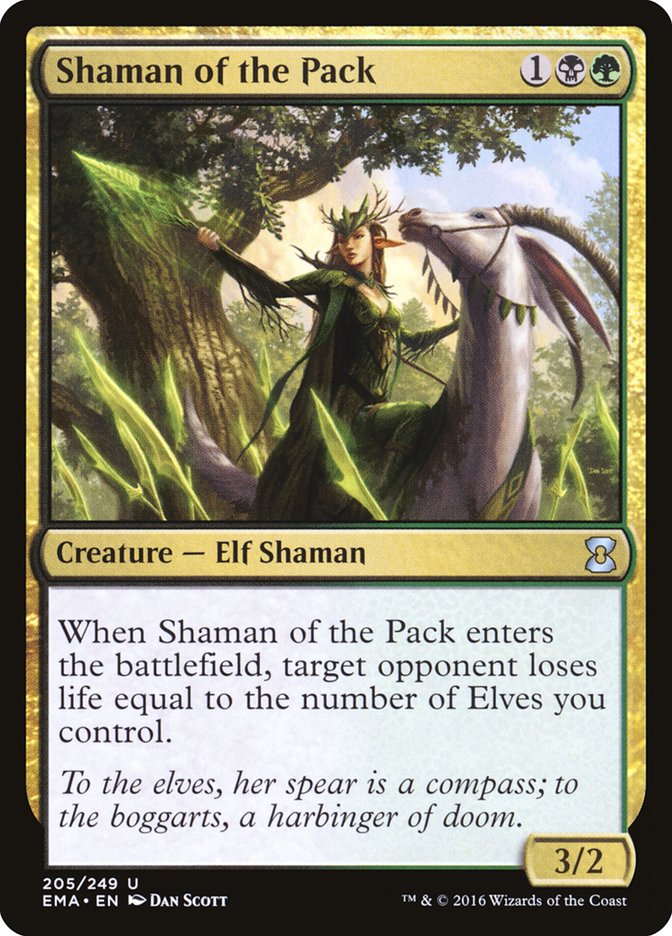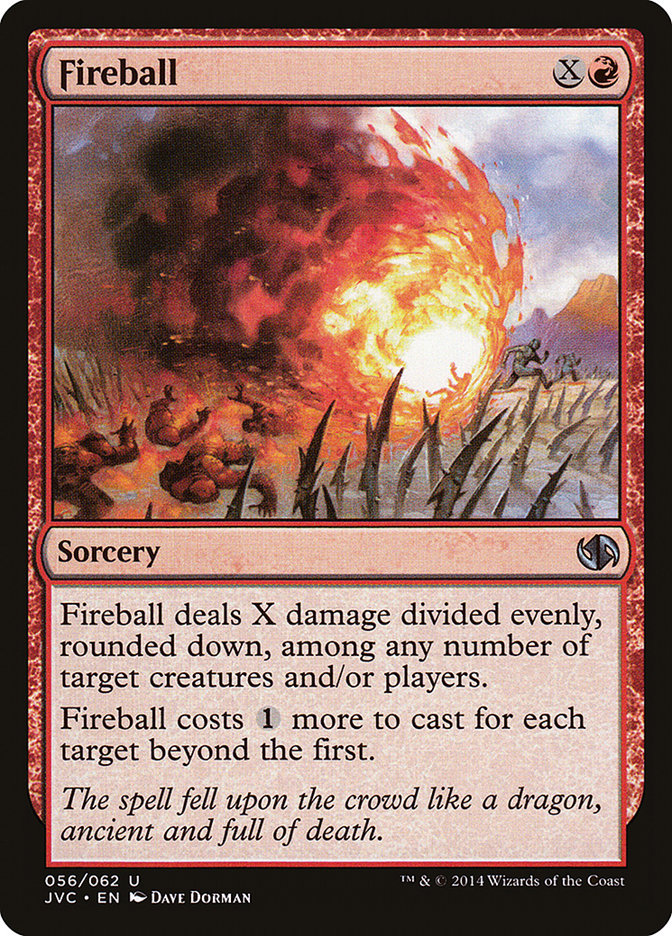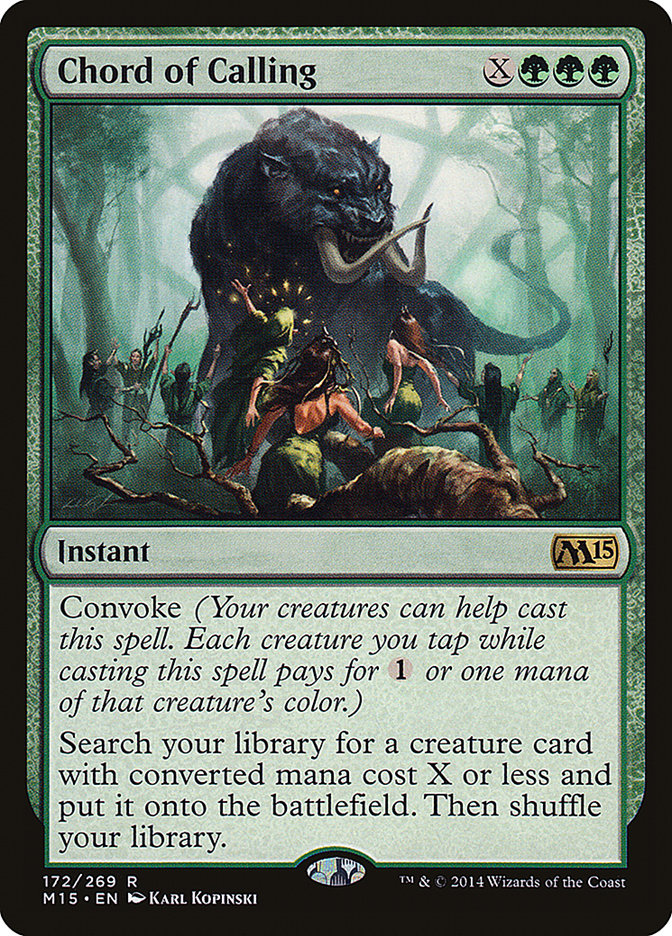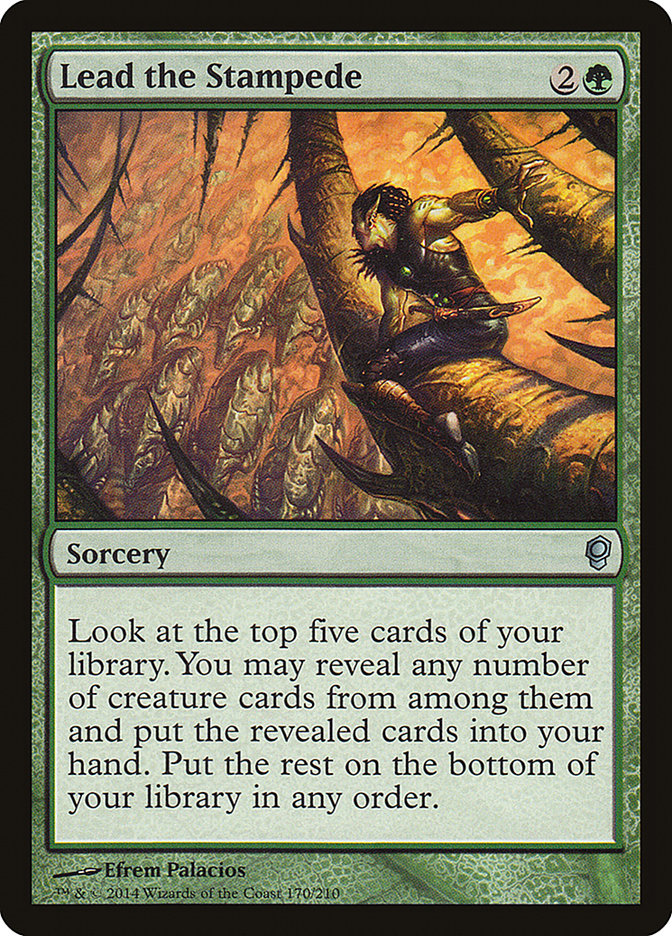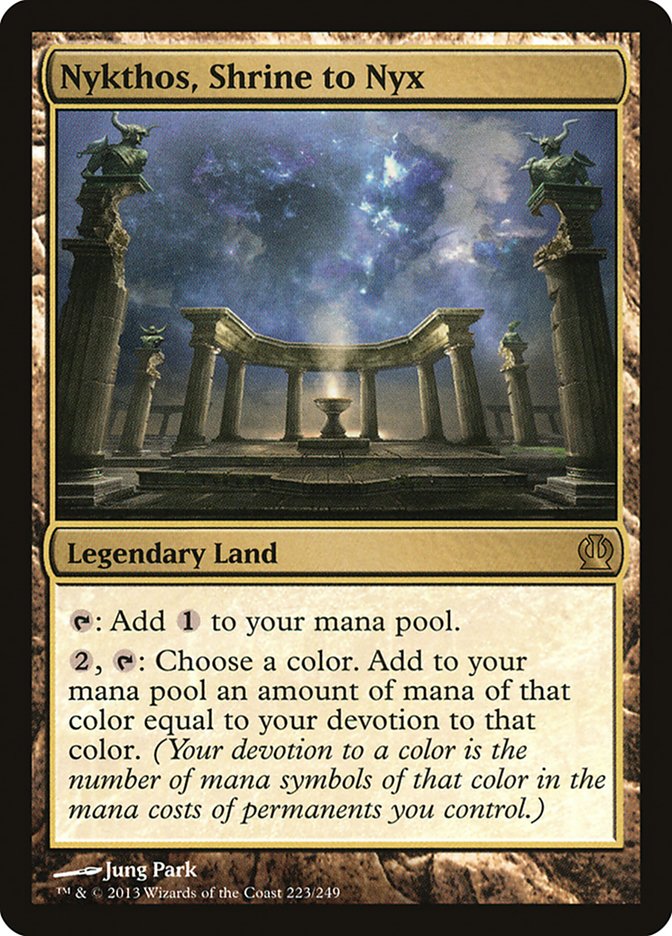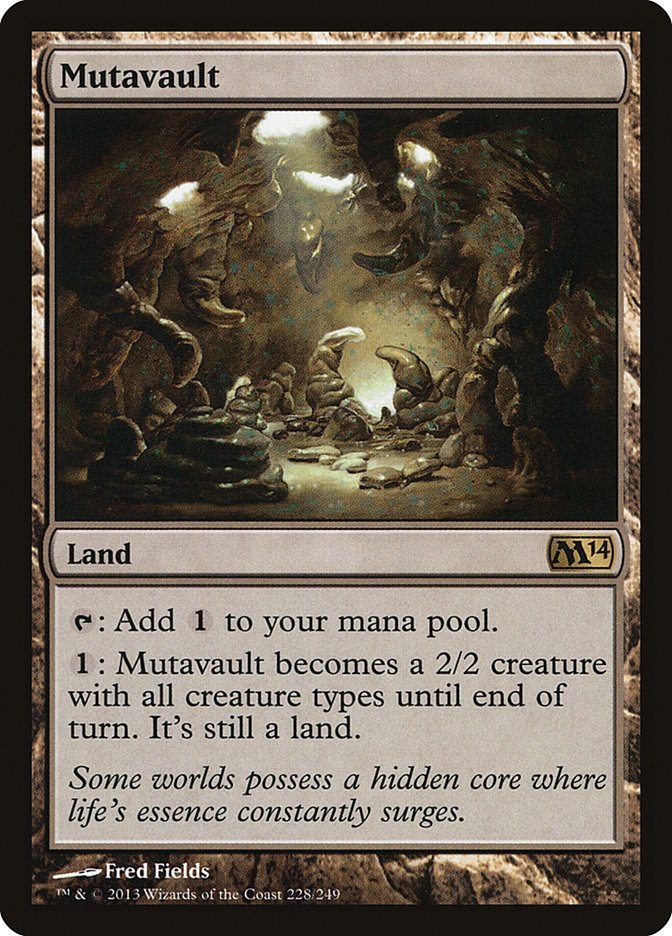Acceleration has always been premium in Magic. If you’re familiar with Eternal formats, you’ve heard the phrase “Bolt the Bird” before. Mana acceleration can create such a tempo advantage that this heuristic is almost always right. Elves is a deck chock-full of little green mana-producing monsters, and it is a Modern deck that is often forgotten. Liam Lonergan took down StarCityGames.com New Jersey Invitational this past summer with the following list:
Creatures (34)
- 4 Llanowar Elves
- 1 Eternal Witness
- 4 Heritage Druid
- 4 Nettle Sentinel
- 3 Elvish Visionary
- 4 Elvish Archdruid
- 3 Ezuri, Renegade Leader
- 1 Spellskite
- 1 Scavenging Ooze
- 4 Elvish Mystic
- 1 Reclamation Sage
- 4 Dwynen's Elite
Lands (18)
Spells (8)

What is Elves trying to do? Go wide. Really really wide. It is not uncommon to have four creatures on the battlefield after turn 1 thanks to Heritage Druid or even just Dwynen’s Elite. When Elvish Archdruid or Ezuri, Renegade Leader is involved, the next turn can be lethal, and turn 4 almost always is.
Elves has a wonderful balance of keeping up to speed with fast decks like Affinity and Burn while simultaneously going too wide and having too much redundancy for decks like Abzan and Jund to win via one-for-one answers. But I don’t believe this is the optimal build of Elves in Modern.
In general, when analyzing a deck for a format, you should look to see if there are cards excluded that improve matchups. And there is one card missing here, a card that improves nearly every single matchup in the format: Shaman of the Pack. Let’s take a look at what this card brings to Elves.
Burn baby burn!
Shaman of the Pack provides both speed and inevitability. Most cards provide one or the other, but the Shaman enables extremely fast starts while also creating an environment where your opponent is never safe. Stabilizing becomes nearly impossible. Shaman of the Pack also increases the potency of both Chord of Calling and Collected Company. And the only cost we have to pay to play this blazing Elf is black mana.
So why is the card excluded from many lists? The main argument is that white has better sideboard cards. You play more sideboarded games than Games 1, and although Shaman of the Pack is beneficial for almost every matchup Game 1, the white cards in the sideboard also have a high impact.
Here is what I don’t get: why not just play Abzan? The majority of white sideboard cards are bullet-style creatures to grab of Collected Company and Chord of Calling anyway; hence, they can impact the game without having white mana. Combine that with the fact that you are already playing Horizon Canopy and can name a non-Elf creature-type for Cavern of Souls, and the mana is pretty much fine! Honestly, I think this is the answer. Too many people are afraid of the mana, but I have been playing Abzan Elves for over a year now and have had no trouble at all. Here is my current list:
Creatures (34)
- 4 Llanowar Elves
- 4 Heritage Druid
- 4 Nettle Sentinel
- 3 Elvish Visionary
- 4 Elvish Archdruid
- 3 Ezuri, Renegade Leader
- 4 Elvish Mystic
- 4 Dwynen's Elite
- 4 Shaman of the Pack
Lands (18)
Spells (8)

Other than the addition of Shaman of the Pack and the change in manabase, I altered one more thing. I favor Lead the Stampede over Chord of Calling in the maindeck. The fact of the matter is, when adding Shaman of the Pack, we no longer can play cards like Spellskite and Reclamation Sage in the main. This turns Chord of Calling into a split card between Fireball (Shaman of the Pack) and Overrun (Ezuri, Renegade Leader). It still has its merits, but I rarely want to draw more than one Chord of Calling, and hence replaced three copies with Lead the Stampede.
Lead the Stampede fixes one of the major downfalls of Elves: mulliganing. Prior to the addition of Lead the Stampede, the deck required such a mass of Elves that mulliganing was detrimental to the plan. Now we have a card that often turns a four-card hand into a seven-card hand. This is huge. Modern is such a fast-paced format that having the ability to mulligan aggressively into a faster hand is important.
Mulliganing
Mulliganing is one of the most important and skillful aspects of Magic, and it is no different with Elves. There are a few heuristics I use to evaluate a hand with Elves.
- Do I have a play on both turn 1 and turn 2? If not, mulligan.
- Do I have three or fewer lands? If not, mulligan.
- Can I produce three mana on turn 2? If not, mulligan.
- Do I have a haymaker (Collected Company; Ezuri, Renegade Leader; Elvish Archdruid; or Lead the Stampede)? If not, mulligan.
These heuristics teach us the spectrum from keepable hands to ideal hands. An unexciting, keepable hand abides by these rules but doesn’t necessarily set the world on fire.
This hand is fine. You can have six power on the battlefield on turn 2 and follow this up with a Collected Company. Hopefully you hit Ezuri, Renegade Leader; Elvish Archdruid; or Shaman of the Pack. The probability of drawing any of these cards in time or finding one or more off Collected Company is over 85%.
The following hand is much closer to ideal.
Why is this hand ideal? The first major difference is Heritage Druid, which allows you to have three creatures and Elvish Archdruid on turn 2. But if you remove Heritage Druid, this is still a spectacular mulligan to six. What makes this hand ideal is the fact that you have two high-impact cards in Collected Company and Elvish Archdruid. Because of this, you can attack well on turn 3 and cast Collected Company.
Sequencing and Plays
Casting Collected Company isn’t easy. Sometimes it’s correct to cast it in combat, sometimes in a main phase, and sometimes on your opponent’s end step. This depends on the deck you are playing against and will be different every game. I can’t give you an end-all-be-all answer, but I can provide some guidance.
The key observation is the juxtaposition of risk and reward. The reward of casting Collected Company pre-combat is additional damage. The risk is, if you don’t affect combat, your opponent now has much more information regarding your next turn. They can plan accordingly.
So when does the reward outweigh the risk? When there is a reasonable probability that you can represent lethal damage, you should cast it on your main phase. It is also important to look a full turn ahead. Sometimes finding an Elvish Archdruid or Shaman of the Pack doesn’t kill them this turn but should next turn. This is another reason to use Collected Company to affect combat.
Matchups with a lot of interaction are ones where you want to play your Collected Company on their end step. Think of the ways your opponent will respond to the different outcomes. Can they beat an Ezuri, Renegade Leader? It can be better to wait until your opponent’s end step to increase the probability they tap out in case Ezuri is in your top six cards.
The last factor that affects when to cast Collected Company is your mana. A very common situation is that you have Collected Company in hand and a couple of other things to do with your mana, such as Lead the Stampede or Elvish Archdruid. Here you cast Collected Company on your main phase: if you find a copy of Heritage Druid, you can cast both spells!
Other than discerning when to deploy Collected Company, there are other intricacies to the deck. You learn them as you play the deck more, but here are useful ones:
- Play Nettle Sentinel on turn 1 if you can use Heritage Druid next turn. It’s an extra two damage!
- Hold priority when you have a Shaman of the Pack trigger. This way you can cast Chord of Calling or Collected Company and get additional damage out of them.
- If you know you will win when you untap with Ezuri, Renegade Leader and you have five mana available but not enough creatures to attack for lethal, don’t do anything. Just pass. Ezuri may not be able to regenerate himself, but he will get +3/+3 should you activate his second ability. This means you can still win through Lightning Bolt!
Sideboarding
You’ve heard it time and time again: you play more games with your sideboard than you do without. Elves has a very specific sideboard plan: bring in extra copies of Chord of Calling and bullet-style creatures that help defeat certain decks. This is another reason I think the deck is great. Modern is a format of hyper-linear decks that all do one thing very well. This means that targeted hate cards are very powerful, and post-sideboard, Elves gets to play four copies of any hate creature thanks to Chord of Calling!
Unfortunately, Modern is so diverse that I could not possibly present a complete sideboard guide. There are just too many decks. So what follows is my sideboard guide, as well as tips and tricks, for many of the popular decks in the format.
Dredge
In:
Out:
Outside of their best draws, this matchup is pretty favorable. Sure, Dredge can put an enormous amount of power on the battlefield early, but you can block everything that isn’t Narcomeba. Dredge’s power is in its resilience, and if they don’t have access to Conflagrate, Elves is faster. And usually, by the time Conflagrate is set up, it’s too late anyway.
Post-sideboard, things can get a little scary. Darkblast is a terrifyingly efficient Magic card against Elves. The plan, as is true against every aggro deck in Modern, is to bring in your bullets and increase the speed of the deck with Chord of Calling. Remove the slower spells like Lead the Stampede and Elvish Visionary.
Yixlid Jailer and Scavenging Ooze do a good job at hindering Dredge and attacking their best cards against Elves. Thragtusk blocks extremely well while buying time if they get a fast start. I’m rarely worried about this matchup, and given Dredge’s popularity, this is a huge plus for Elves!
Jund
In:
Out (plus a flex slot):
Jund is one of the few matchups where you don’t bring in extra copies of Chord of Calling. There is no need to be faster, just more resilient. Every card added provides a level of resilience to the deck and the cards removed required the most card quantity to go right. Heritage Druid combined with Nettle Sentinel may be the best acceleration in the deck, but it’s too easy for Jund to pick away at your Elves to keep this at bay.
I do recommend keeping one Chord of Calling in the deck though. Having the ability to counter removal and sweepers at instant speed is useful. Combine that with the fact that Chord can act as a second copy of Chameleon Colossus, a card that Jund is almost incapable of beating, and one copy seems optimal.
Infect
In:
Out:
The plan here is to take out all the clunky cards. Elves is a very lean deck full of cheap spells. But Lead the Stampede and Elvish Visionary usually fulfill the role of refueling your hand in order to keep playing and dig towards more action. The problem is that Infect is just too fast. Having these cards in your opening hand can slow down your clock by a turn. That’s enough to lose the game.
Infect is one of the few bad matchups for Elves. There are two ways to win Game 1. The more common is that their only threat is a Glistener Elf, because you will always have a blocker while progressing your gameplan. The other is to, and I hate to say this, get lucky. Get a nutty starting hand that kills on turn 2 or 3 or hope that they don’t have it and race.
So how do you increase your chances post-sideboard? You’ll see that I have two copies of Melira, Sylvok Outcast and one copy of Spellskite. These cards shut down Infect. Since Infect is so popular, I have opted for two copies of Melira rather than two copies of Spellskite. The reason for this is Twisted Image. Should your metagame have a higher concentration of decks like Burn, I would recommend swapping the numbers.
Affinity
In:
Out:
Hopefully you have noticed the pattern by now. Sideboarding against aggro decks with Elves is fairly straightforward: out with the clunky and in with the bullets. So we bring in the artifact hate and Phyrexian Revoker to take care of whatever’s necessary, given the deck’s dependence on activated abilities. Selfless Spirit is in here because Whipflare is a huge problem post-sideboard, and it also blocks a flier equipped with a Cranial Plating!
It should be noted that Spellskite also has its merits, but I don’t find it necessary to bring in. Spellskite nullifies Arcbound Ravager and it also helps beat Ghirapur Aether Grid, but sometimes it just does nothing.
Tip: Do not aggressively cast Chord of Calling for Reclamation Sage. Yes, this play is very good, but your best bet is to use Chord reactively. Let them attack you and go for a more risky play. If they don’t kill you, cast Chord of Calling to grab Ezuri, Renegade Leader instead. Otherwise protect yourself with Reclamation Sage.
Bant Eldrazi
In:
Out:
Bant Eldrazi is just too slow. Thought-Knot Seer doesn’t come down early enough and Elves is too redundant anyway. Elves goes too wide for Eldrazi Displacer to do anything significant. And Path to Exile is not efficient against the gameplan of Elves.
The important thing to note about sideboarding here is to be mindful of the converted mana cost of your Elves. Outside of Engineered Explosives, Bant Eldrazi can’t really prevent a swarm. Their best bet is to hope that Worship gets the job done, which is why you should bring in a copy of Reclamation Sage just in case Shaman of the Pack isn’t potent enough at the time.
Burn
In:
Out:
This matchup is quite even, and sometimes it feels a little too dependent on the die roll. On the draw it’s almost impossible to beat Eidolon of the Great Revel, and Searing Blaze is an absolute beating too. But when Elves is on the play, those cards don’t impact the game nearly as much and we can race.
As far as sideboarding goes, Reclamation Sage is extremely important. Answering Eidolon of the Great Revel is necessary for success in this matchup. Add in Spellskite and Thragtusk for good measure and it is pretty hard for Burn to finish the game. Just remember to play around Skullcrack and Atarka’s Command when using Chord of Calling to get Thragtusk.
Tip: On the play, it is often correct to lead on Nettle Sentinel in this matchup. Given that Burn’s best turn 1 plays are Goblin Guide and Monastary Swiftspear, a 2/2 blocker can be worth more than a mana creature!
In:
Out:
Shaman of the Pack is such a wonderful Magic card. It turns out that when your opponent is trying to lower their own life total, Fireball is pretty freaking good. The usual way this matchup ends in favor of Death’s Shadow is Temur Battle Rage. You almost always have an expendable Elf to block with, and none of their creatures have trample without that combat trick.
Taking all this into consideration, Chord of Calling is the most important card in this matchup, and I sincerely consider mulliganing hands that don’t have it. The ability to guarantee an instant-speed Shaman of the Pack for lethal or save yourself from Temur Battle Rage with Spellskite is too valuable.
Tip: If you are unlikely to kill your opponent off Collected Company on your turn, this can change on their turn because of Death’s Shadow’s tendency for self-harm. Even though you might increase damage by casting Collected Company pre-combat on your turn, it is often correct to do this after their combat phase instead so they don’t get the bonus.
Tron
In:
Out:
Luckily for us, and thanks to Tom Ross, G/W Tron is the popular variant at the moment. This matchup is almost unwinnable against G/R Tron because of Pyroclasm. But if you are playing against G/RTron, I would also board in Selfless Spirit and take out a Nettle Sentinel. I like leaving in a Lead the Stampede in order to rebuild after Pyroclasm if you’re lucky.
As far as the G/W Tron matchup is concerned, Elves is favored. Karn Liberated is too slow and Wurmcoil Engine really doesn’t get the job done every time. A turn 4 Ugin, the Spirit Dragon is one of the ways they beat you, so don’t forget that.
This means you only use Chord of Calling in two scenarios. The first is getting Shaman of the Pack or Ezuri, Renegade Leader for lethal, and the second is to find Phyrexian Revoker to prevent Ugin, the Spirit Dragon from ruining your fun. It is rarely correct in this matchup to use Chord of Calling to increase damage because the only way Tron comes back from behind is Ugin (and Oblivion Stone to a lesser extent).
Now, you’re probably thinking “If we almost always sideboard out Elvish Visionary and Lead the Stampede, why are we even playing them?” Both Elvish Visionary and Lead the Stampede provide card velocity, and they are never useless Game 1. Elves has such a strong sideboard plan because it can replace this generally good filler with haymaker cards.
You could choose to play the full set of Chord of Calling in the main and replace Elvish Visionary with cards sideboarded in frequently, such as Scavenging Ooze, Spellskite, and Reclamation Sage, but drawing cards that don’t affect the gameplan is a real cost, and losing Lead the Stampede also adds to the cost of mulliganing.
Everything is a tradeoff. Elves is a very customizable deck, and I have provided the list that I would take to the next Modern event. But before I let you go, I want to introduce you to some technology I am currently testing for Elves.
Nykthos, Shrine to Nyx is a one-of in almost every Elves list. The cost of a colorless land is less than the benefit. A colorless land causes a mulligan by being the only land in hand in less than two percent of games, so a little less than once per large tournament. This cost is small enough that a utility land definitely has a place here. But why Nykthos?
I find that Nykthos, Shrine to Nyx often does nothing. And when it does win the game, I’m winning anyway. Yes, there are times when I can only activate Ezuri, Renegade Leader because of Nykthos, but that is actually quite rare.
Now consider the card Mutavault. It’s not as splashy and impactful as Nykthos, Shrine to Nyx, but it will almost always be relevant. An extra attacker is nothing to scoff at!
Mutavault also does many little things for Elves. You can activate it for an extra damage from Shaman of the Pack. It is nearly free to activate when you have an Elvish Archdruid. And getting a third Elf for Heritage Druid actually lets Mutavault generate additional mana!
There is one more scenario that makes a difference, and a big reason as to why I’m beginning to lean towards Mutavault over Nykthos, Shrine to Nyx. It is pretty common to have Elvish Archdruid and three other Elves on turn 3. A turn 4 Ezuri, Renegade Leader and activate is not guaranteed lethal in this case. You are usually attacking for fifteen or sixteen damage. Mutavault brings this number up to above twenty.
All in all, Elves is a blast to play and puts up a good fight against the majority of the field in modern. It is extremely malleable and adapting the deck for your expected metagame is easy. So go dig through your box for your old Llanowar Elves and sleeve this up for your next Modern Event!


